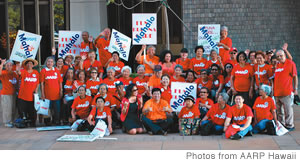Our Long-term Care Crisis

By Barbara Kim Stanton
State Director, AARP Hawaii
With strong bipartisan support, the Legislature endorsed the need for senior care by passing Senate Bill 2469, which provides $3.5 million from the Rainy Day Fund for Kupuna Care. AARP Hawaii is calling on Gov. Linda Lingle to sign the bill and release the funds. Without it, counties will be forced to cut back long-term care services to the elderly in their homes.
Kupuna Care is a cost-effective and compassionate statewide program that offers basic services to seniors in need. It provides home-delivered meals, help with personal care such as bathing and dressing, light housekeeping and transportation to the doctor. Equally important, it provides respite for thousands of unpaid care-givers throughout the state who struggle daily to care for the vast majority of our frail elderly. As a home- and community-based program, Kupuna Care is one solution that shifts the cost of long-term care in the right direction.
If the cost of long-term care isn’t on your radar yet, it should be. Hawaii has among the highest nursing home costs in the country, and middle-income residents have few options. Basically, you can live at home with the help of a family caregiver supplemented by home- and community-based services, or you can move to a nursing home. Since home care is typically one third the cost of a nursing home, it’s the preferred option. The enormous cost of institutional care would quickly deplete a family’s assets and impoverish most of us in a very short time. We could then turn to Medicaid - the state and federally funded program that picks up much of the long-term care costs in Hawaii - but the high cost would then be shifted to taxpayers.

|
It doesn’t have to be that way. The logical choice is to provide adequate funding for home- and community-based programs like Kupuna Care to help middle-income residents avoid turning to Medicaid.
Without programs like Kupuna Care, Hawaii’s elder-care crisis will worsen as our population ages. Today, about 14 percent of Hawaii’s population is age 65 or older. Members of this age group will grow by 78 percent over the next two decades. Meanwhile, the number of people age 50-64 - the ranks from which many family caregivers come - will decline by 10 percent during that time. Right now we have about 169,000 family caregivers across the state providing a staggering $1.45 billion in unpaid services each year. How will we compensate for the loss of that care when Hawaii’s elderly outnumber those who care for them?
On the bright side, Hawaii residents are living longer compared to people in other states. But we must ensure that the quality of life of residents age 65 and older is as good as it can be. Kupuna Care meets a growing community need and saves taxpayers in the long run. We should do everything possible to preserve this program going forward.
E-mail this story | Print this page | Comments (0) | Archive | RSS Comments (0) |
Most Recent Comment(s):




 Del.icio.us
Del.icio.us








